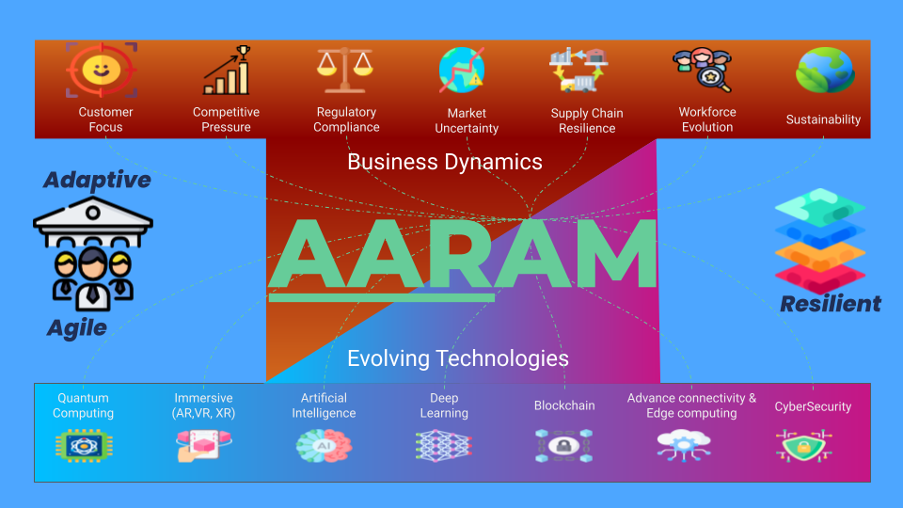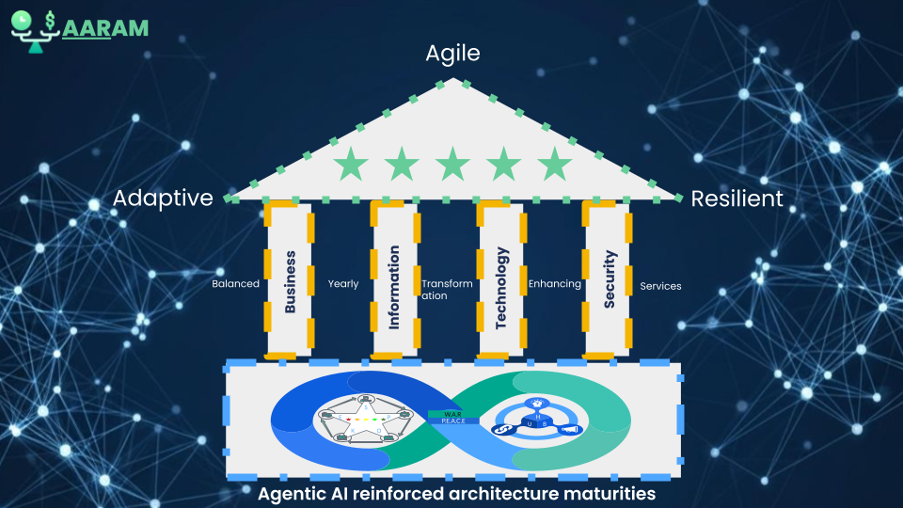
(Editor’s Note: This article represents part three of an ongoing series. Part one, appeared on August 18, entitled “The Unavoidable ‘SCREAM’: Why Enterprise Architecture Must Transform for the Organization of Tomorrow“, introduced the conceptual overview. Part two, “The Anatomy of SCREAM: A Perfect Storm in EA Cupboard” detailed the current state of chaotic SCREAM.)
Ask any organization today about their aspirations beyond SCREAM —those situational chaotic realities—and there is a common pattern. They yearn to be adaptive, capable of responding to whatever tomorrow’s landscape may look like. They strive to be agile, navigating change with speed and creativity. And most importantly, they wish to be resilient, absorbing unexpected changes without disrupting their customers, partners, or operational costs.
The north star for Enterprise Architecture (EA) is AARAM: Adaptive, Agile, Resilient Architecture Management.

Figure 1: Visualizing AARAM: A holistic view of Adaptive, Agile, Resilient Architecture Management, integrating AI-driven insights to align business and technology for enterprise equilibrium.
The Vision: Achieving Enterprise Equilibrium
AARAM represents a desired state where enterprises achieve perfect equilibrium between business and technology alignment. In this vision, digital twins eliminate the distinction between digital and physical operations, creating seamlessly interconnected systems where actions in one realm immediately manifest in the other.
The Core Reality: In these days of pervasive AI, organizations cannot solely rely on siloed architecture work. The winning organizations will be those that can cost-effectively manage their enterprise architecture—the central nervous system managing both the core USP of the organization and the aligned ecosystem of vendors and partners through multitudes of agents.
The true value of EA lies in its ability to connect and synchronize disparate parts of the enterprise, ensuring they function as a cohesive whole. In today’s interconnected business ecosystem, organizational survival depends on architectural alignment—not just internal efficiency, but seamless integration across partners, vendors, and digital touchpoints.
The ultimate goal: a self-healing, self-learning enterprise—a true nervous system for business.
Information in the Agentic Space
Here’s the fundamental equation: Business needs Information, enabled by Technology and secure by design, to operate at full potential.
Yet the “Information” component remains one of the greatest enterprise challenges. Structured and unstructured data in countless formats continues to fly across organizational silos. Too often, it remains fragmented—digital footprints that fail to coalesce into the insights leaders urgently need.
Even as boardrooms race to enable AI and CIOs champion immediate implementation, the foundational challenge persists: without disciplined data management, the transformative promise of AI remains elusive.
This is where the paradigm shifts dramatically. Organizations of tomorrow can leverage AI not just as a capability, but as a Co-Architect (COArCH)—an AI-powered partner that helps build the very foundations it needs to succeed.
Introducing AARAM: Intentional Duality
AARAM serves two complementary purposes:
The Outcome: Adaptive, Agile, Resilient Architecture Management – organizations that can sense, respond, and evolve continuously.
The enabling construct: Agentic AI Reinforced Architecture Maturities – leveraging AI agents to systematically enhance organizational capabilities.
Agentic AI Reinforced Architecture Maturities systematically harness datasets as digital footprints of every operational process, enabling enterprises to not only assess their current maturity but also follow a balanced, incremental path toward the next.
At any given point, maturity is visible across architecture domains, layers, and components, as well as at abstraction and aggregation levels along key lifecycle changes. AARAM outcomes are measured through indicators that directly reflect its core principles: Adaptive Capacity (time-to-response for market changes), Agile Throughput (decision velocity and cross-functional collaboration effectiveness), and Resilience Index (system recovery time and performance under stress). Additional metrics include Architectural Debt reduction and the AI-Human Collaboration Quotient
The Paradigm Shift: From People-Dependent to System-Dependent
The days of “people-dependent systems” are rapidly waning. Tomorrow belongs to “system-dependent people,” fundamentally driven by the rise of generative AI. This paradigm shift leads to our target state: AARAM.
Architecture is evolving from rigid, deterministic models to agentic architectures where autonomous agents act with minimal human intervention. Organizations like MIT are pioneering frameworks for networked AI agents in decentralized architectures, extending Zero Trust principles into the agentic realm. The result: verifiable, trustworthy, and interoperable ecosystems of intelligent services.
The Mathematical Enterprise Reality: Every organization runs on underlying mathematical principles—optimization variables that traditionally remained invisible. In the AARAM state, these principles become visible and actionable, enabling predictive adaptation, optimal resource allocation, strategic acceleration, and real-time scenario testing.
Equally critical is the social blueprint—understanding how people actually collaborate and where organizational friction exists. Mapping and optimizing this human element ensures that AI augmentation enhances both efficiency and employee satisfaction.

Figure 2: The Agentic Enterprise: Core agents and AI-driven systems working in harmony to drive continuous maturity and strategic differentiation in an interconnected ecosystem.
Core Agents vs. Commoditized AI
The critical strategic challenge in an agentic world lies in distinguishing between core agents and commoditized vendor agents.
Platforms like Google Agentspace, Microsoft Copilot Studio, and Amazon Q deliver powerful but standardized capabilities. While operationally useful, these are accessible to all competitors. The true competitive advantage lies in core agents—those that encapsulate proprietary data, institutional knowledge, unique processes, and deep customer understanding.
These core agents represent the organization’s digital DNA—its Unique Selling Proposition (USP) encoded in AI form. In a world of ubiquitous AI capabilities, the ability to build, manage, and evolve these proprietary agents becomes the ultimate differentiator.
Managing this agentic space requires a new breed of techno-functional expertise—leaders who understand both architectural principles and business operations at depth. This is where sustainable competitive advantage resides.
The real problem most companies face is that their employees don’t have the right skills—but this creates both challenges and opportunities. The skill transformation would be key to achieve AARAM.
The AARAM Advantage
The organizations that master AARAM first will define the next decade of business advantage through several key capabilities:
- Speed: AI-augmented architecture decisions at machine speed
- Intelligence: Pattern recognition across vast organizational data
- Adaptability: Real-time response to market and operational changes
- Resilience: Self-healing systems that maintain performance under stress
- Competitive Edge: Proprietary AI agents that competitors cannot replicate
These organizations will operate with AI-augmented decision-making, self-optimizing processes, and proprietary intelligence that competitors cannot match. Organizations that begin their AARAM journey now will establish capabilities that become increasingly difficult for competitors to replicate.
The Path Forward: System-Driven EA
AARAM represents system-driven architecture management—moving beyond executive directives to AI-powered, data-driven architectural evolutions. The enterprise architect’s role must transform rather than being bogged down by the sheer volume of knowledge bases and frameworks that have accumulated since the dawn of information technology.
Embracing the Human- AI Partnership
Let’s confidently cede control to the machine where it excels. AI systems are becoming, or indeed already are, smarter than the average human in specific tasks. Look at autonomous vehicles that navigate better than human drivers without fatigue, or robots performing complex manufacturing processes with unparalleled precision.
The enterprise architect role becomes that of a “strategic advisor and board operator” for enterprise architecture management. We guide the organization through its maturities, leveraging these powerful new capabilities while maintaining strategic control over the pace and direction of evolution.
Humans provide strategic vision, creativity, and business insight. AI agents deliver scale, speed, pattern recognition, and continuous optimization. Together, they create something neither could achieve alone.
This transformation doesn’t require demolishing existing systems. AARAM can be implemented incrementally, building AI capabilities that enhance rather than replace current architectures.
This industry has always been fast-growing, and it will continue to be so. But our ability to strategically accelerate or decelerate its evolution, to guide its direction, is now squarely in our hands.
The move from SCREAM to AARAM is a journey requiring continuous effort, executive sponsorship, and focus on measurable outcomes. The future belongs to organizations that can balance human insight with AI capability, creating enterprises that are not just efficient, but truly intelligent and adaptive.
The Transformation Begins Now
The question is no longer whether this transformation will happen. Forward-thinking organizations are beginning their AARAM journey, building the AI-augmented capabilities that will define future success.
The real question is how quickly and strategically these organizations will embrace AARAM and secure their competitive advantage.
Challenges abound in this evolving space.
The methodology for making AARAM a reality—the practical details and approach for transformation—comes next.
Appendix: Acronyms and Key Terms
The following acronyms and terms are used in the article “The Co-Architect EA: Enterprise AARAM Through AI” to describe concepts related to enterprise architecture, AI-driven transformation, and organizational maturity.
- AARAM: Adaptive, Agile, Resilient Architecture Management
A dual framework encompassing the desired state of enterprise architecture (adaptive, agile, resilient organizations) and the method to achieve it through AI-driven maturities. - SCREAM: Situational Chaotic Realities of Enterprise Architecture Management
The chaotic, siloed, and inefficient state of current enterprise architecture practices, as introduced in parts one and two of the series. - COArCH: Co-Architect
An AI-powered architectural assistant that leverages data and AI to support enterprise architects in achieving incremental organizational maturities. - EA: Enterprise Architecture
The discipline of designing, planning, and managing an organization’s structure, processes, and technology to align business strategy with IT capabilities. - USP: Unique Selling Proposition
The distinctive value or competitive advantage an organization offers, embodied in its proprietary data, processes, and AI agents. - Agentic AI:
Artificial intelligence systems capable of autonomous decision-making and action, used in AARAM to process data, recognize patterns, and drive continuous improvement. - Core Agents:
Proprietary AI agents that encapsulate an organization’s unique intellectual property, data, and operational knowledge, distinguishing them from commoditized vendor-provided agents. - Digital Twin:
A virtual representation of physical or operational systems, enabling real-time monitoring and simulation to align digital and physical operations seamlessly. - Social Blueprint:
A mapping of organizational collaboration patterns and friction points, optimized through AI to enhance efficiency and employee satisfaction. - DAMA: Data Management Association
An international organization providing standards and best practices for data management, referenced as a foundational body of knowledge for AARAM. - NIST: National Institute of Standards and Technology
A U.S. agency that develops frameworks for cybersecurity and data management, supporting AARAM’s maturity assessment processes. - TOGAF: The Open Group Architecture Framework
A methodology for developing enterprise architecture, providing structured approaches to align IT with business goals, referenced as a supporting framework for AARAM. - ZTAA: Zero Trust Agentic Access
An extension of Zero Trust security principles to autonomous AI agents, ensuring secure and controlled interactions in decentralized architectures.
